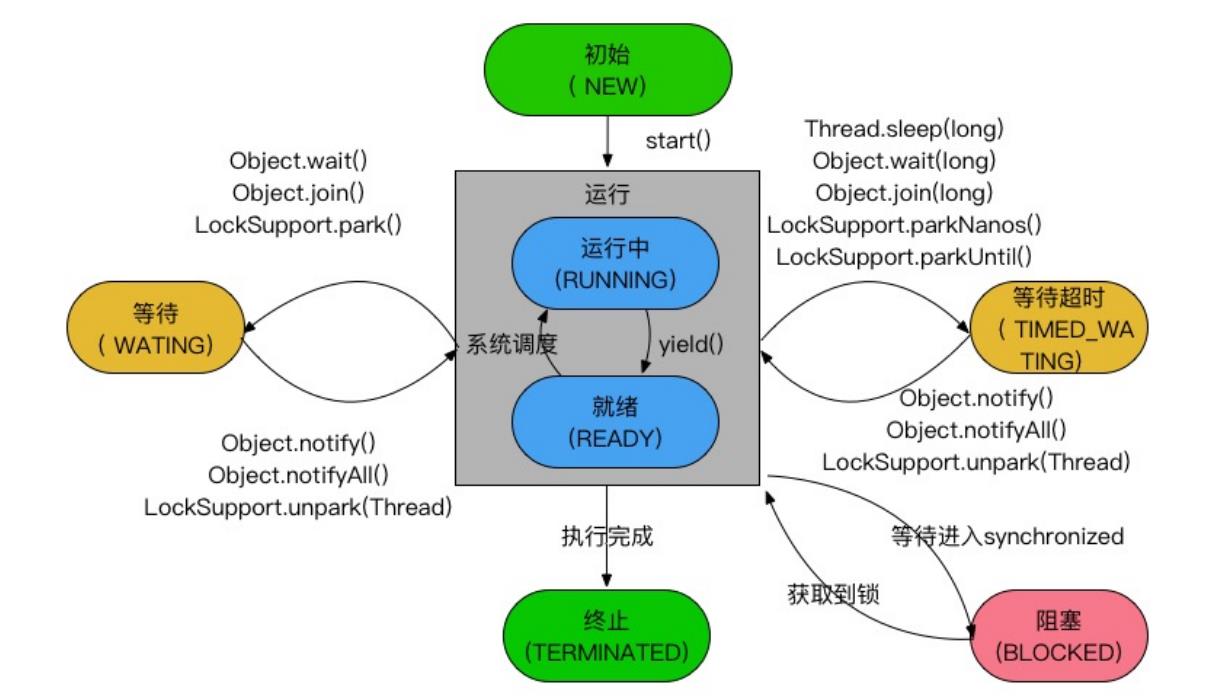JUC并发编程 -- 回顾多线程(线程的六种状态 & wait / sleep 的区别)
Posted Z && Y
tags:
篇首语:本文由小常识网(cha138.com)小编为大家整理,主要介绍了JUC并发编程 -- 回顾多线程(线程的六种状态 & wait / sleep 的区别)相关的知识,希望对你有一定的参考价值。
1. 回顾多线程
1.1 线程的六种状态
Thread.State源码:
public enum State {
/**
* Thread state for a thread which has not yet started.
*/
NEW,
/**
* Thread state for a runnable thread. A thread in the runnable
* state is executing in the Java virtual machine but it may
* be waiting for other resources from the operating system
* such as processor.
*/
RUNNABLE,
/**
* Thread state for a thread blocked waiting for a monitor lock.
* A thread in the blocked state is waiting for a monitor lock
* to enter a synchronized block/method or
* reenter a synchronized block/method after calling
* {@link Object#wait() Object.wait}.
*/
BLOCKED,
/**
* Thread state for a waiting thread.
* A thread is in the waiting state due to calling one of the
* following methods:
* <ul>
* <li>{@link Object#wait() Object.wait} with no timeout</li>
* <li>{@link #join() Thread.join} with no timeout</li>
* <li>{@link LockSupport#park() LockSupport.park}</li>
* </ul>
*
* <p>A thread in the waiting state is waiting for another thread to
* perform a particular action.
*
* For example, a thread that has called <tt>Object.wait()</tt>
* on an object is waiting for another thread to call
* <tt>Object.notify()</tt> or <tt>Object.notifyAll()</tt> on
* that object. A thread that has called <tt>Thread.join()</tt>
* is waiting for a specified thread to terminate.
*/
WAITING,
/**
* Thread state for a waiting thread with a specified waiting time.
* A thread is in the timed waiting state due to calling one of
* the following methods with a specified positive waiting time:
* <ul>
* <li>{@link #sleep Thread.sleep}</li>
* <li>{@link Object#wait(long) Object.wait} with timeout</li>
* <li>{@link #join(long) Thread.join} with timeout</li>
* <li>{@link LockSupport#parkNanos LockSupport.parkNanos}</li>
* <li>{@link LockSupport#parkUntil LockSupport.parkUntil}</li>
* </ul>
*/
TIMED_WAITING,
/**
* Thread state for a terminated thread.
* The thread has completed execution.
*/
TERMINATED;
}
- 初始(NEW):新创建了一个线程对象,但还没有调用start()方法。
- 运行(RUNNABLE):Java线程中将就绪(ready)和运行中(running)两种状态统称为称为“运行”。
- 线程对象创建后,其他线程(比如main线程)调用了该对象的start()方法。该状态的线程位于可运行线程池中,等待被线程调度选中,获取cpu 的使用权,此时处于就绪状态(ready)。就绪状态的线程在获得cpu 时间片后变为运行中状态(running)。
- 阻塞(BLOCKED):表线程阻塞于锁。
- 等待(WAITING):进入该状态的线程需要等待其他线程做出一些特定动作(通知或中断)。
- 超时等待(TIME_WAITING):该状态不同于WAITING,它可以在指定的时间内自行返回。
- 终止(TERMINATED):表示该线程已经执行完毕。
Java线程状态变迁图:

1.2 状态详细说明
1.2.1 初始状态(NEW)
- 实现Runnable接口和继承Thread可以得到一个线程类,new一个实例出来,线程就进入了初始状态。
1.2.2 就绪状态(RUNNABLE之READY)

1.2.3 运行中状态(RUNNABLE之RUNNING)
- 线程调度程序从可运行池中选择一个线程作为当前线程时线程所处的状态。这也是线程进入运行状态的唯一的一种方式。
1.2.4 阻塞状态(BLOCKED)
- 阻塞状态是线程阻塞在进入synchronized关键字修饰的方法或代码块(获取锁)时的状态。
1.2.5 等待(WAITING)
- 处于这种状态的线程不会被分配CPU执行时间,它们要等待被显式地唤醒,否则会处于无限期等待的状态。
1.2.6 超时等待(TIMED_WAITING)
- 处于这种状态的线程不会被分配CPU执行时间,不过无须无限期等待被其他线程显示地唤醒,在达到一定时间后它们会自动唤醒。
1.2.7 终止状态(TERMINATED)
- 当线程的run()方法完成时,或者主线程的main()方法完成时,我们就认为它终止了。这个线程对象也许是活的,但是它已经不是一个单独执行的线程。线程一旦终止了,就不能复生。
- 在一个终止的线程上调用start()方法,会抛出java.lang.IllegalThreadStateException异常。
1.3 wait / sleep 的区别
来自不同的类:
- 这两个方法来自不同的类分别是,sleep来自Thread类,和wait来自Object类。
- sleep是Thread的静态方法,谁调用的谁去睡觉,即使在a线程里调用了b的sleep方法,实际上还是a去睡觉,要让b线程睡觉要在b的代码中调用sleep。
有没有释放锁(释放资源):
- 最主要是sleep方法没有释放锁,而wait方法释放了锁,使得其他线程可以使用同步控制块或者方法。
- sleep是线程被调用时,占着cpu去睡觉,其他线程不能占用cpu,os(操作系统)认为该线程正在工作,不会让出系统资源,wait是进入等待池等待,让出系统资源,其他线程可以占用cpu。sleep(100L)是占用cpu,线程休眠100毫秒,其他进程不能再占用cpu资源,wait(100L)是进入等待池中等待,交出cpu等系统资源供其他进程使用,在这100毫秒中,该线程可以被其他线程notify,但不同的是其他在等待池中的线程不被notify不会出来,但这个线程在等待100毫秒后会自动进入就绪队列等待系统分配资源,换句话说,sleep(100)在100毫秒后肯定会运行,但wait在100毫秒后还有等待os调用分配资源,所以wait100的停止运行时间是不确定的,但至少是100毫秒。
- 就是说sleep有时间限制的就像闹钟一样到时候就叫了,而wait是无限期的除非用户主动notify。
使用范围不同:
wait,notify和notifyAll只能在同步控制方法或者同步控制块里面使用,而sleep可以在任何地方使用
以上是关于JUC并发编程 -- 回顾多线程(线程的六种状态 & wait / sleep 的区别)的主要内容,如果未能解决你的问题,请参考以下文章